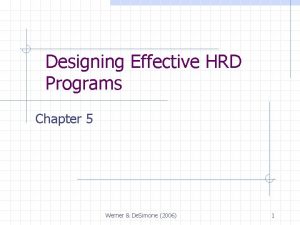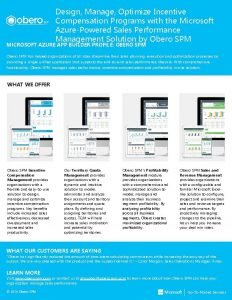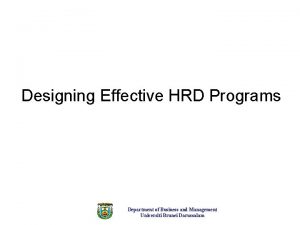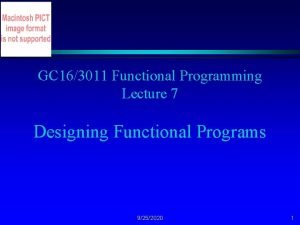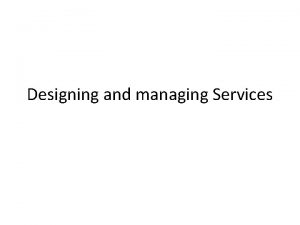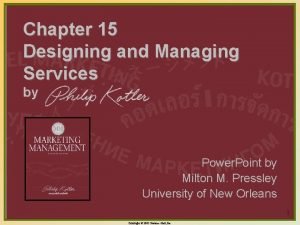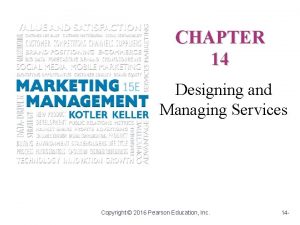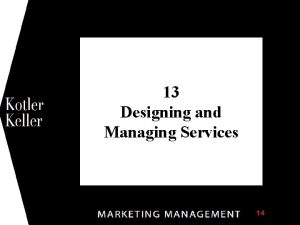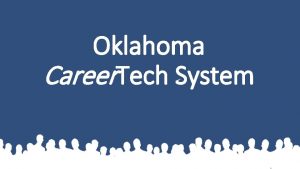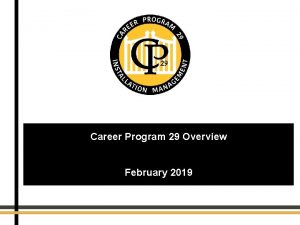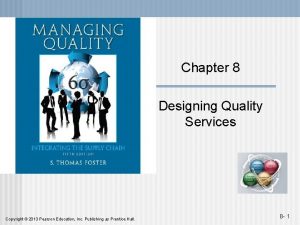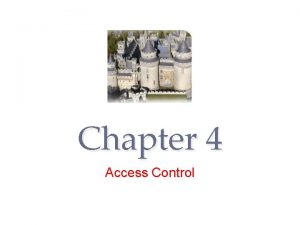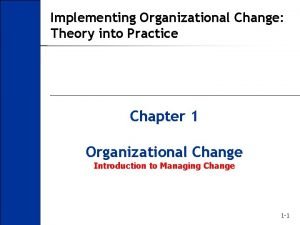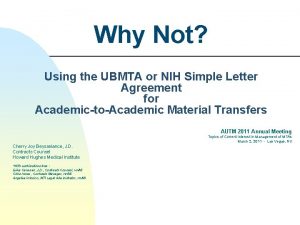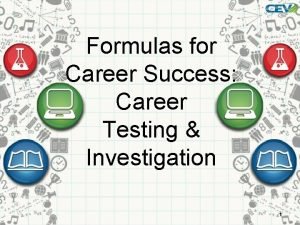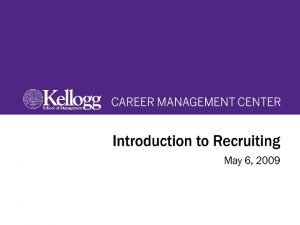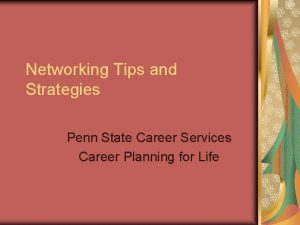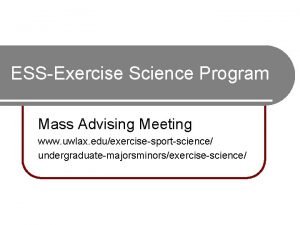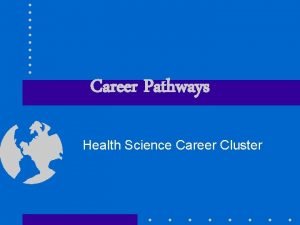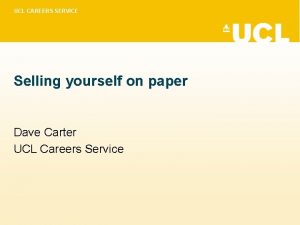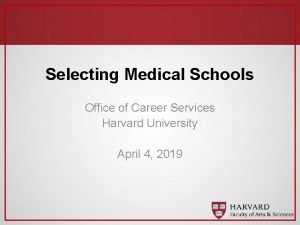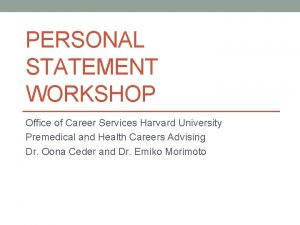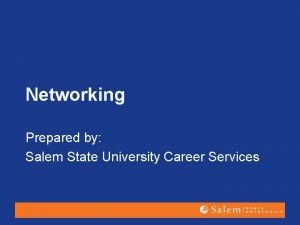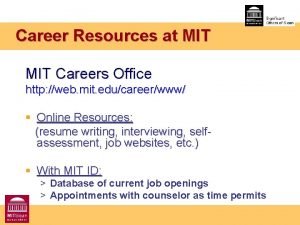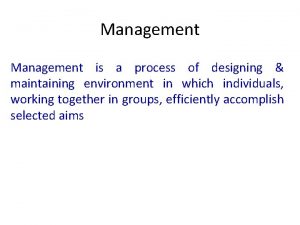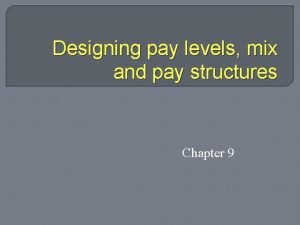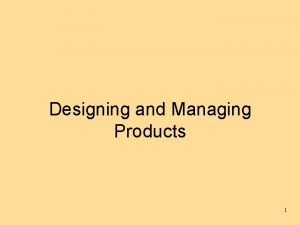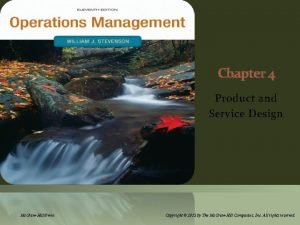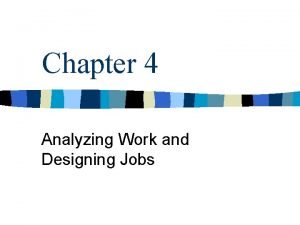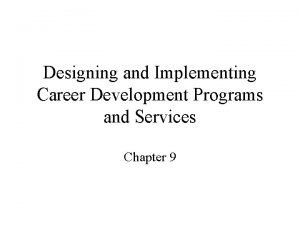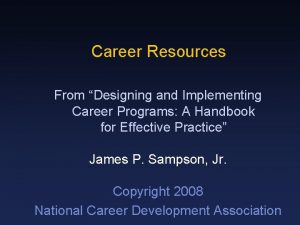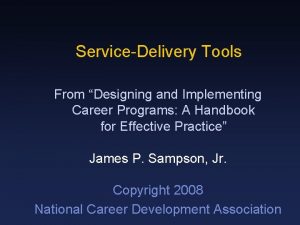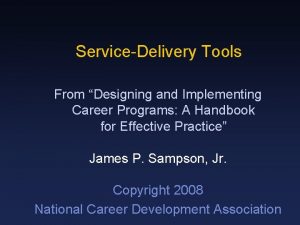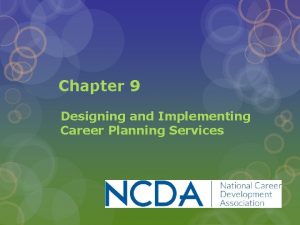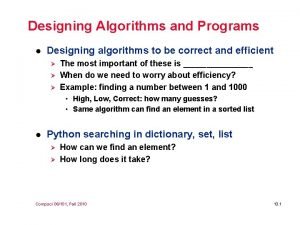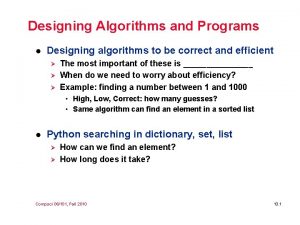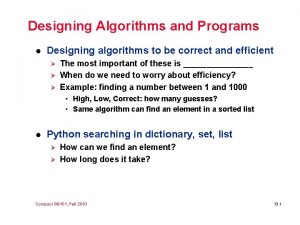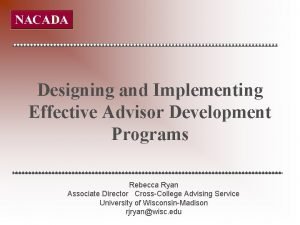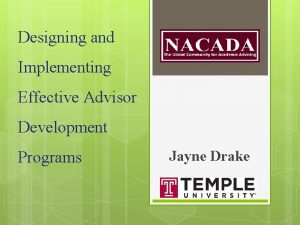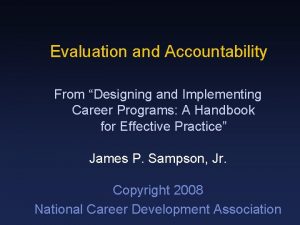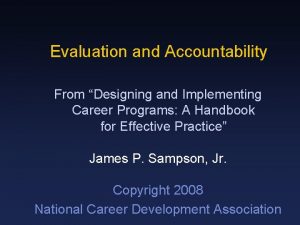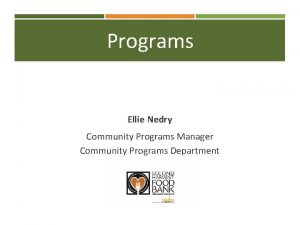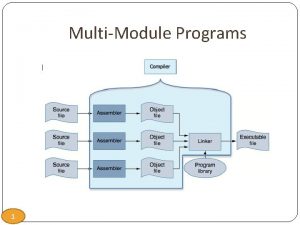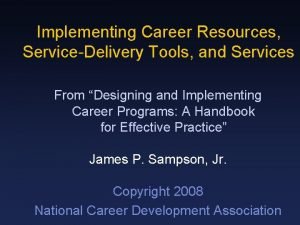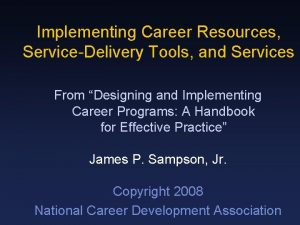Career Services From Designing and Implementing Career Programs



































































- Slides: 67

Career Services From “Designing and Implementing Career Programs: A Handbook for Effective Practice” James P. Sampson, Jr. Copyright 2008 National Career Development Association

Organization of the Presentation • Readiness for Career Choice • Three Levels of Service Delivery • Seven-Step Service Delivery Sequence • Steps in Promoting Effective Use of Career Resources • Service Delivery at a Distance 2

Family Factors • Few responsibilities and family support (positive) • Deferral, e. g. , compromise career development to meet needs of spouse or children or parents (negative) • Role overload, e. g. , roles of worker, parent, son/daughter, homemaker, student (negative) • Dysfunctional family input, e. g. , overfunctioning parents (negative)

Social Factors • Social support, e. g. modeling, networking, and caring (positive) • Discrimination, e. g. age, disability, ethnicity, gender, immigration status, nationality, occupation, physical characteristics, poverty level, race, religion, sexual orientation, and social class (negative) • Stereotyping, lack of role models, bias in education, and harassment in education and employment (negative)

Economic Factors • General factors, e. g. rate of change in the labor market influences stability of occupational knowledge – stable knowledge (positive), unstable knowledge (negative) • Personal factors, e. g. influence of poverty on housing, health care, and childcare – adequate resources are positive, inadequate resources (negative)

Organizational Factors (If the person is employed) • Size, e. g. , size of internal employment market – small internal job market is less complex (positive), large internal job market is more complicated (negative) • Organizational culture, e. g. , amount of support provided for career development – more support (positive), less support (negative) • Stability, e. g. , employment opportunities – more stability is positive, less stability (negative)

Two-Dimensional Readiness Model Complexity (high) Capability (low) (high) (low)

Two-Dimensional Readiness Model Complexity (high) Low readiness High degree of support needed (Individual Case. Managed Services) Capability (low) Moderate readiness Moderate to low degree of support needed (Brief Staff-Assisted Services) (high) Moderate readiness Moderate to low degree of support needed (Brief Staff-Assisted Services) High readiness No support needed ( Self-Help Mode) (low)

Three Levels of Service Delivery • Instead of one level of service for all, three levels of service are needed to meet individual needs ranging from those who are: – self-motivated and able to learn successfully on their own – suffering from low readiness for decisionmaking who need substantial assistance to successfully learn 15

Three Levels of Service Delivery • The three levels of service include – Self-help services for young people and adults with high readiness for decision making – Brief staff-assisted services for young people and adults with moderate readiness – Individual case-managed services for young people and adults with low readiness 16

Aim of the 3 Service Delivery Levels • Young people and adults should receive the level of help they need, no more and no less • The aim of the differentiated service delivery model (the CIP approach) is to provide – the right resource – used by the right person – with the right level of support – at the lowest possible cost 17

Screening • Screening is key to the success of differentiated service delivery • Screening avoids – Overserving high readiness young people and adults with costly individualized interventions that are not needed – Underserving low readiness young people and adults with inadequate interventions from staff who are unaware of the substantial needs of the young person or adult 18

Screening • Screening provides staff with a better chance to cost-effectively meet the needs of young people and adults in career centers and schools 19

Screening • Screening also helps to better allocate staff resources – Staff will be able to serve more young people and adults, or – spend more time with young people and adults with substantial needs • Two types of screening – Brief – Comprehensive 20

Brief Screening • Brief screening occurs upon entry to the career resource room in a school or career center • A sign can be used that indicates “First-Time Users Stop Here” – Shows where brief screening occurs – Allows repeat users of the resource room to move directly to the resources or services they need 21

Brief Screening Individual Enters Sign indicates “First-Time Users Stop Here” Brief Screening Staff ask “What brings you here today? ” A young person or adult enters a resource room in a school or career center

Brief Screening • Young people and adults who enter the career center are greeted by a staff member who might say, “What brings you here today? ” • If the young person or adult responds with a concrete request for information, and there are no problems apparent, the individual is judged to have high readiness for career choice and is referred to self-help resources with staff support as needed 23

Brief Screening “What brings you here today? ” “I would like to find information comparing the starting salaries of accountants and auditors” This is a concrete request for information with no problems apparent No further screening needed Refer to self-help services 24

Brief Screening "Could I see information on the job outlook for computer programmers? " Would not require more careful screening "I am having difficulty choosing a training program that is right for me, " Would require more careful screening 25

Brief Screening Individual Enters Brief Screening Self-Help Services Staff judge that a young person’s or adult’s needs can be met with self-help resources

Self-Help Services • For young people and adults with high readiness for career decision making • Minimal assistance is provided to young people and adults • The use of career resources is guided by each individual • Selection and sequencing of career resources is determined by the information provided in the resource guides 27

Self-Help Services • Minimal assistance is provided, although staff – periodically check to see if young people and adults are successfully using career resources – are available to respond to questions • Resource guides suggest selected assessment, information, or instructional resources to meet specific needs 28

Self-Help Services • Signage and maps help young people and adults to locate self-help career resources • Instructions for using career resources are contained within each resource • Young people and adults can gain remote access to some of the career resources by accessing the Career Center Web site 29

Problems in Using Self-Help Resources Problems young people and adults have in effectively using resources are detected by staff members circulating among young people and adults and asking "Are you finding the information you need? " If problems are apparent, then more careful screening occurs 30

Problems in Using Self-Help Resources The safety net “Are you finding the information you need? ” Individual Enters Brief Screening Self or Staff Referral Comprehensive Screening Self-Help Services If more help is needed in using resources, then needs are reassessed

Brief to Comprehensive Screening Individual Enters Brief Screening Comprehensive Screening Brief screening indicates that a more careful career assessment is needed

Brief to Comprehensive Screening • Examples of comprehensive screening can include – A brief diagnostic test – A brief interview 33

Comprehensive Screening Individual Enters Brief Screening After assessing individual needs in comprehensive screening, staff judge that some assistance is necessary Comprehensive Screening Brief Staff-Assisted Services Career resources are identified on an Individual Learning Plan (ILP)

Brief Staff-Assisted Services • For young people and adults with moderate readiness for career decision making • Moderate assistance is provided to young people and adults • The use of career resources is guided by a staff member • Selection and sequencing of career resources is indicated on an individual learning plan (ILP) 35

Brief Staff-Assisted Services • Drop-in services • Shorter-term group counseling • Career courses with large-group interaction • Workshops 36

Drop-In Services • Staff-guided use of resources in a career resource room in a school or career center • Staff complete scheduled time in the career resource room with young people and adults served on a first-come, first-served basis • Continuity in service delivery results from teamwork and collaboratively-developed written individual learning plans (ILPs) 37

Drop-In Services • Young people and adults are not restricted to the available appointment times of any one staff member – A person can decide to see the same staff member by returning the next time the person is on duty – Or, a person can return any time the career center is open and see a staff member on duty 38

Drop-In Services • Young people and adults (with staff input) decide how much time is needed to use career resources • Responsive to typical periods of high and low demand by increasing or decreasing the number of staff working in the resource room • High volume of young people and adults can be served • Lowers service-delivery costs 39

Drop-In Services • Requires staff to – Establish relationships quickly – Clarify progress in completing an ILP – Revise the ILP if new needs become apparent – Serve multiple young people and adults during one period of time – Participate in common staff training 40

Drop-In Services • Provides young people and adults with immediate follow-up of resource use. – Opportunity to facilitate learning during the “teachable moment”. 41

Comprehensive Screening Individual Enters Brief Screening After assessing individual needs in comprehensive screening, staff judge that substantial assistance is necessary Comprehensive Screening Individual Case-Managed Services Again, career resources are identified on an Individual Learning Plan

Individual Case-Managed Services • For young people and adults with low readiness for career decision making • Substantial assistance provided • The use of career resources is guided by a staff member • Selection and sequencing of career resources is indicated on an individual learning plan (ILP) 43

Individual Case-Managed Services • Individual counseling • Longer-term group counseling • Career courses with frequent small-group interaction 44

Moving Between Levels of Service • Readiness for career decision making can improve over time • Persons can move between levels of service delivery • Or, some individuals have difficulty in using resources and need more help, and move to a higher level of service 45

Differentiated Service Delivery Model Individual Enters Brief Screening Self or Staff Referral Comprehensive Screening Self-Help Services Brief Staff-Assisted Services Individual Case-Managed Services Complete differentiated model of delivering career resources and services

Assumptions of the Model • All young people and adults are greeted as they enter the career resource room by a trained staff member • Young people and adults can seek assistance on a self-help basis 47

Assumptions of the Model • If problems occur with the use of selfhelp resources, staff are available to reassess needs and make further recommendations about the use career resources and an appropriate level of service delivery 48

Assumptions of the Model • Young people and adults and staff collaborate in deciding on an appropriate level of service delivery and appropriate resources 49

Assumptions of the Model • Resource guides and individual learning plans are available to help young people and adults select, locate, sequence, and use resources • No matter what the level of service delivery provided (including self-help), staff periodically check with all young people and adults to determine if their needs are being met 50

Seven-Step Sequence for Services 1. Initial interview 2. Preliminary assessment 3. Define problem and identify causes 4. Formulate goals 5. Develop an individual learning plan 6. Complete the individual learning plan 7. Summative review and generalization 51

Initial Interview Gain information about the young person or adult’s problem The brief screening process also occurs at this step 52

Initial Interview “What brings you here today? ” "Can I see a list of local training programs? " Concrete request - no problems apparent No further screening needed referral to self-help resources 53

Initial Interview Potential error in brief screening Problematic use of resources detected by staff (the safety net), "Are you finding the information you need? " If problems are apparent, more careful screening then occurs. 54

Initial Interview "I have not done well in my training program and I don't know what to do. " Vague request - potential problems More careful screening needed prior to delivering services 55

Preliminary Assessment Diagnostic assessment used to provide information about the young person or adult’s problem and readiness for decision making • Diagnostic measure • Diagnostic interview • Includes the comprehensive screening process described earlier 56

Define Problem and Identify Causes Understand the problem as a gap between where the person is and where the person needs to be Consider possible causes 57

Formulate Goals The practitioner and the young person or adult develop goals to narrow the gap

Develop an Individual Learning Plan • Help the person to identify a sequence of resources and activities to meet their goals 59

Differences in Plans • An individual learning plan is not a personal career plan – An individual career plan is a list of the steps necessary to become employed, such as completing training and job search – An individual learning plan only identifies the resources and services used to make decisions at various points in a person’s career plan 60

Complete the Individual Learning Plan Follow-through with the ILP Staff provide – encouragement – clarification – modeling – reinforcement 61

Summative Review and Generalization Discuss progress toward achieving goals Make plans for future use of services Discuss future use of problem-solving skills 62

Steps in Promoting Effective Use of Career Resources Four-step process 1. Understanding 2. Recommending 3. Orienting 4. Follow-up 63

Four-Step Process • Understanding – Clarifying the career assessment and information needs of an adolescent or adult • Recommending – Suggestions about career assessments and information on the ILP that are appropriate for the needs of the adolescent or adult 64

Four-Step Process • Orienting – Preparing adolescents and adults to make effective use of career assessments and information • Follow-Up – Checking that adolescents and adults have appropriately used the resources and services on their ILP and that they have a plan of action for the future 65

Service Delivery at a Distance • Deliver services through the use of e-mail, chat, telephone, or videoconferencing • Delivered to persons who may – be underserved with face-to-face services – prefer the convenience of remote assistance 66

Distance Counseling as a Necessity • Persons with disabilities who have mobility problems • Persons in remote geographic areas who lack access to resources and services • Persons seeking access to practitioners in other locations with specialized expertise • Persons reluctant to seek help who use the Internet as a safe place to start obtaining 67 resources and services

Distance Counseling as a Convenience • Persons who want to access resources and receive services outside of normal business hours • Persons who want to access resources and receive services at their place of residence or work 68

Three Levels of Service Delivery • Self-help services – Responding to questions about Web-site use • Brief staff-assisted services – Screening, recommending, orienting, and follow-up of Web-site use • Individual case-managed services – Individual counseling at a distance 69

Ethical Issues • Informed consent • Client suitability • Client access and financial capability • Counselor competence • Training • Credentialing 70

Ethical Issues • Client technology skills • Confidentiality • Cultural sensitivity • Right of redress • Limited awareness of location-specific issues • Lack of clarity about practitioner credentials 71

References Sampson, J. P. , Jr. (2008). Designing and implementing career programs: A handbook for effective practice. Broken Arrow, OK: National Career Development Association. 72

For more information www. career. fsu. edu/techcenter
 Designing and implementing brand strategies
Designing and implementing brand strategies Designing and implementing brand architecture strategies
Designing and implementing brand architecture strategies Designing and implementing brand architecture strategies
Designing and implementing brand architecture strategies Implementing hrd programs
Implementing hrd programs Designing effective hrd programs
Designing effective hrd programs Obero spm
Obero spm Hrd design
Hrd design Marketing programs to build brand equity
Marketing programs to build brand equity Designing functional programs
Designing functional programs Collection of programs written to service other programs.
Collection of programs written to service other programs. Designing and managing service processes
Designing and managing service processes Designing and managing services
Designing and managing services Designing and managing services ppt
Designing and managing services ppt Designing and managing services
Designing and managing services Oklahoma career tech programs
Oklahoma career tech programs Army setm
Army setm Designing quality services
Designing quality services Management issues central to strategy implementation
Management issues central to strategy implementation Implement strategies management issues
Implement strategies management issues Chapter 7 strategic management
Chapter 7 strategic management Setting prices and implementing revenue management
Setting prices and implementing revenue management Crm project plan
Crm project plan Implementing strategies management and operations issues
Implementing strategies management and operations issues Implementing strategies management and operations issues
Implementing strategies management and operations issues Retail management notes doc
Retail management notes doc Process oriented learning competencies
Process oriented learning competencies Implementing qsen competencies
Implementing qsen competencies Challenges of implementing predictive analytics
Challenges of implementing predictive analytics Implementing organizational change spector
Implementing organizational change spector Finance and accounting issues in strategy implementation
Finance and accounting issues in strategy implementation Access rights definition
Access rights definition Project selection and portfolio management
Project selection and portfolio management Nfpa 1600
Nfpa 1600 Implementing organizational change theory into practice
Implementing organizational change theory into practice Autm ubmta
Autm ubmta Nfpa 1600 business continuity programs
Nfpa 1600 business continuity programs Zpf cisco
Zpf cisco National career clusters
National career clusters Formulas for career success career testing & investigation
Formulas for career success career testing & investigation -is not one of the purposes for giving oral presentations.
-is not one of the purposes for giving oral presentations. Architecture is the art and science of designing buildings
Architecture is the art and science of designing buildings Kellogg career management center
Kellogg career management center Wfu opcd
Wfu opcd Career services penn state harrisburg
Career services penn state harrisburg Therapeutic services pathway
Therapeutic services pathway Uwlax career services
Uwlax career services Health science career cluster jobs
Health science career cluster jobs Hawkmail hfcc
Hawkmail hfcc Dave carter ucl
Dave carter ucl Harvard career center
Harvard career center Harvard office of career services
Harvard office of career services Jobtrekker
Jobtrekker Drake beam morin outplacement services
Drake beam morin outplacement services Fsu career portfolio
Fsu career portfolio Jhsph career services
Jhsph career services Salem state career services
Salem state career services Marissa marsala
Marissa marsala Usm career services
Usm career services Babson college
Babson college Diffserv vs intserv
Diffserv vs intserv Wake county human services community services center
Wake county human services community services center The process of designing and maintaining an environment
The process of designing and maintaining an environment Computer aided embroidery and designing
Computer aided embroidery and designing Designing pay structure
Designing pay structure Managing products and brands
Managing products and brands Product and service design
Product and service design Analyzing work and designing jobs
Analyzing work and designing jobs Interface and dialogue design
Interface and dialogue design




